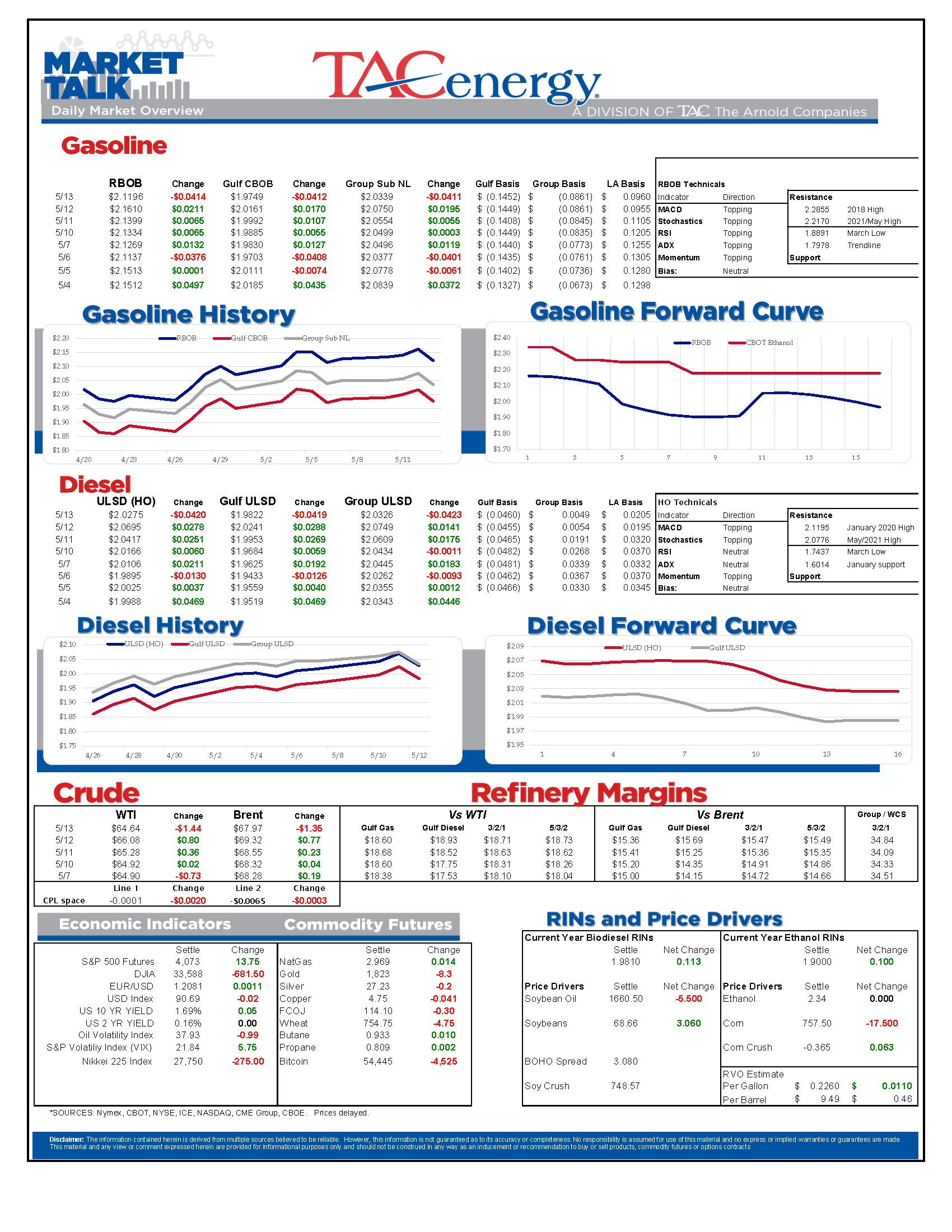Inflation Reaches A 13-Year High

Colonial pipeline began restarting operations Wednesday night, and products futures dropped a nickel. Now that the headlines will move on to other stories, traders can no longer shrug off the big selloff in equity markets this week as inflation has reached a 13 year high, and will also consider the looming drop in demand as consumers will (hopefully) stop filling plastic bags with gasoline. Although the media attention will quickly fade once there are no longer lines of cars outside of gas stations to take pictures of, this situation may have changed perception of the refined fuel industry that many were prepared to cancel just a few weeks ago.
While it may take another couple of weeks for the supply network to truly get back to “normal” as long as product starts flowing again the outages will quickly start to fade. Colonial had not been running at capacity for more than a year prior to this shutdown, so there’s room for extra supply to start moving up the line as operations ramp back up. Values for space on the main gasoline line (Line 1) went positive this week for the first time in over a year as shippers of all varieties wait in the starting blocks to begin the resupply race.
Just as we turn the page on one transportation bottleneck, another one showed up as the I-40 bridge in Memphis was forced to shut after a crack was discovered, disrupting a busy trucking corridor and promising to make an already tight freight market even worse. No word yet if consumers are lining up around Graceland to hoard Elvis memorabilia due to this temporary outage. The good news is that trucks heading to the Valero refinery in Memphis to help supplement supplies across the Southeast during the Colonial downtime don’t have to cross that bridge, but Arkansas suppliers will struggle with this situation.
The DOE’s weekly report Wednesday gave a dose of reality to those expecting demand to hit pre-COVID levels this summer. Total petroleum demand had its biggest weekly drop since stay at home orders smashed all records last year. While gasoline and diesel estimates did see minor declines, most of the huge drop came in the “other oils” category and doesn’t reflect a drop in consumer activity.
U.S. refining capacity dropped another 50mb/day last week, as the permanent closures announced last year continue to make their way into the official numbers. The drop from 19 million barrels/day two years ago to 18 million today is the worst decline in capacity in nearly 40 years.
Adding fuel to the 200 proof fire: U.S. ethanol inventories dropped to a four-year-low last week, even though ethanol production ticked up by 25mb/day. There’s still another 50mb/day or so of production that hasn’t returned since the pandemic started.
RIN Values continue their parabolic move. D6 ethanol RINS were trading around $.36/RIN this time last year, hit $.80 to start 2021, were at $1.31 a month ago and then shot to $1.90 yesterday. D4 values are approaching the $2 mark. With ethanol, grain and refined products appearing to be topping out and the demand for imports looking like it will subside thanks to the Colonial restart, the stage is set for a pullback, but the big question is will it be of the collapse variety that the wild RIN market has seen in years’ past or a more modest correction since the refiner obligation for the year is still unknown?
The best cure for high prices is high prices: Eight companies – Tesla being one of them – have petitioned to be allowed to generate RINs via their electric vehicle production. While it could be years before congress can even get around to reviewing those proposals, and more years before they’d be implemented if signed into law, it’s a good reminder that at $2/RIN there will be no shortage of new producers trying to take advantage of the RFS program.
Crying uncle: Carl Icahn’s attempt to takeover Delek via a proxy & media battle has failed and CVR announced it would distribute the Delek shares it had accumulated as a special dividend as a result.
The last straw? The refinery FKA as Hovensa was forced to shut again this week after yet another disruption that rained oil on the surrounding neighborhoods. With the EPA already investigating the facility for permit violations, it seems like the efforts to restart this facility that was closed in 2012 may ultimately fall flat.
Latest Posts
The Sell-Off Continues In Energy Markets, RBOB Gasoline Futures Are Now Down Nearly 13 Cents In The Past Two Days
Week 15 - US DOE Inventory Recap
Prices To Lease Space On Colonial’s Main Gasoline Line Continue To Rally This Week
Equity Markets Have Been Pulling Back Sharply In Recent Days As Inflation And Trade Concerns Inject A Sense Of Reality Into Stocks
Social Media
News & Views
View All
The Sell-Off Continues In Energy Markets, RBOB Gasoline Futures Are Now Down Nearly 13 Cents In The Past Two Days
The sell-off continues in energy markets. RBOB gasoline futures are now down nearly 13 cents in the past two days, and have fallen 16 cents from a week ago, leading to questions about whether or not we’ve seen the seasonal peak in gasoline prices. ULSD futures are also coming under heavy selling pressure, dropping 15 cents so far this week and are trading at their lowest level since January 3rd.
The drop on the weekly chart certainly takes away the upside momentum for gasoline that still favored a run at the $3 mark just a few days ago, but the longer term up-trend that helped propel a 90-cent increase since mid-December is still intact as long as prices stay above the $2.60 mark for the next week. If diesel prices break below $2.50 there’s a strong possibility that we see another 30 cent price drop in the next couple of weeks.
An unwind of long positions after Iran’s attack on Israel was swatted out of the sky without further escalation (so far anyway) and reports that Russia is resuming refinery runs, both seeming to be contributing factors to the sharp pullback in prices.
Along with the uncertainty about where the next attacks may or may not occur, and if they will have any meaningful impact on supply, come no shortage of rumors about potential SPR releases or how OPEC might respond to the crisis. The only thing that’s certain at this point, is that there’s much more spare capacity for both oil production and refining now than there was 2 years ago, which seems to be helping keep a lid on prices despite so much tension.
In addition, for those that remember the chaos in oil markets 50 years ago sparked by similar events in and around Israel, read this note from the NY Times on why things are different this time around.
The DOE’s weekly status report was largely ignored in the midst of the big sell-off Wednesday, with few noteworthy items in the report.
Diesel demand did see a strong recovery from last week’s throwaway figure that proves the vulnerability of the weekly estimates, particularly the week after a holiday, but that did nothing to slow the sell-off in ULSD futures.
Perhaps the biggest next of the week was that the agency made its seasonal changes to nameplate refining capacity as facilities emerged from their spring maintenance.
PADD 2 saw an increase of 36mb/day, and PADD 3 increased by 72mb/day, both of which set new records for regional capacity. PADD 5 meanwhile continued its slow-motion decline, losing another 30mb/day of capacity as California’s war of attrition against the industry continues. It’s worth noting that given the glacial pace of EIA reporting on the topic, we’re unlikely to see the impact of Rodeo’s conversion in the official numbers until next year.
Speaking of which, if you believe the PADD 5 diesel chart below that suggests the region is running out of the fuel, when in fact there’s an excess in most local markets, you haven’t been paying attention. Gasoline inventories on the West Coast however do appear consistent with reality as less refining output and a lack of resupply options both continue to create headaches for suppliers.

Week 15 - US DOE Inventory Recap

Prices To Lease Space On Colonial’s Main Gasoline Line Continue To Rally This Week
Energy markets are sliding lower again to start Wednesday’s trading as demand concerns and weaker stock markets around the world seem to be outweighing any supply concerns for the time being.
Rumors continue to swirl about an “imminent” response by Israel to Iran’s attacks, but so far, no news seems to be taken as good news in the hopes that further escalation can be avoided, even as tensions near the Red Sea and Strait of Hormuz continue to simmer.
Prices to lease space on Colonial’s main gasoline line continue to rally this week, trading north of 11 cents/gallon as Gulf Coast producers still struggle to find outlets for their production, despite a healthy export market. Gulf Coast CBOB is trading at discounts of around 34 cents to futures, while Gulf Coast RBOB is trading around a 16-cent discount, which gives shippers room to pay up for the linespace and still deliver into the East Coast markets at a profit.
Back to reality, or just the start of more volatility? California CARBOB basis values have dropped back to “only” 40 cent premiums to RBOB futures this week, as multiple flaring events at California refineries don’t appear to have impacted supply. The state has been an island for fuel supplies for many years as its boutique grades prevent imports from neighboring states, and now add the conversion of the P66 Rodeo refinery to renewable diesel production and the pending changes to try and cap refinery profits, and it’s easier to understand why these markets are increasingly vulnerable to supply shocks and price spikes on gasoline.
RIN prices continue to fall this week, touching 44 cents/RIN for D4 and D6 values Tuesday, their lowest level in 6 weeks and just about a nickel above a 4-year low. While the sharp drop in RIN and LCFS values has caused several biodiesel and Renewable Diesel producers to either shut down or limit production, the growth in RIN generation continues thanks to projects like the Rodeo refinery conversion, making the supply in RINs still outpace the demand set by the Renewable Fuel Standard by a wide margin.
The API reported draws in refined products, 2.5 million barrels for gasoline and 427,000 barrels for distillates, while crude oil stocks had an estimated build of more than 4 million barrels. The DOE’s weekly report is due out at its normal time this morning.
Click here to download a PDF of today's TACenergy Market Talk.
